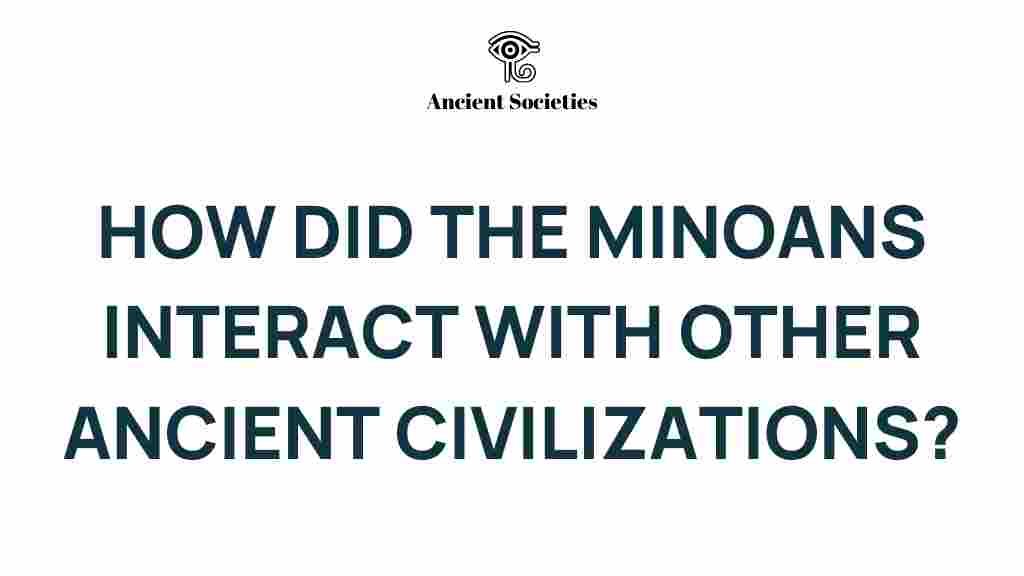Minoans: Connections with Ancient Civilizations
The Minoans were one of the earliest advanced civilizations in Europe, flourishing on the island of Crete during the Aegean Bronze Age, approximately from 2700 to 1450 BCE. This enigmatic society is a cornerstone of Mediterranean history, providing insights into the interactions and connections between ancient civilizations. Through trade, culture, and archaeology, the Minoans significantly influenced neighboring societies and played a pivotal role in the development of the ancient Mediterranean world.
The Rise of Minoan Civilization
The Minoans emerged as a dominant civilization in the Mediterranean, characterized by their sophisticated architecture, art, and a complex social structure. Their capital, Knossos, is perhaps the most famous archaeological site, showcasing the grandeur of Minoan palaces.
- Architecture: The Minoans built large palatial complexes, featuring advanced drainage systems and elaborate frescoes.
- Art: Minoan art is known for its vibrant colors and depictions of nature, animals, and religious rituals.
- Society: The Minoan society was likely matriarchal, with a strong emphasis on trade and maritime activities.
Trade: The Lifeblood of Minoan Society
Trade was essential to the Minoans, facilitating their connections with other ancient civilizations. They established trade networks across the Mediterranean, exchanging goods such as:
- Olive oil: A staple product that was highly valued in the ancient world.
- Pottery: Minoan pottery is renowned for its beauty and craftsmanship, often traded with other cultures.
- Textiles: The Minoans produced fine fabrics that were sought after in trade.
The Minoans traded not only goods but also ideas and cultural practices, which enriched their society and influenced those they interacted with. Their maritime prowess allowed them to establish connections with various civilizations, including the Egyptians, Mesopotamians, and later the Greeks.
Archaeological Discoveries: Unlocking Minoan History
Archaeology has played a crucial role in unraveling the mysteries of the Minoans. Key discoveries include:
- The Palace of Knossos: Excavated by Sir Arthur Evans in the early 20th century, revealing intricate frescoes and advanced architectural techniques.
- Frescoes: Vibrant wall paintings that depict scenes of nature, rituals, and daily life, offering insights into Minoan culture.
- Linear A Script: An undeciphered writing system that remains a mystery, hinting at a complex administrative system.
These archaeological findings have significantly contributed to our understanding of Minoan culture and their interactions with other ancient civilizations.
The Minoans and Their Influence on Ancient Civilizations
The influence of the Minoans extended beyond their island, impacting various ancient civilizations in the Mediterranean region. The following points highlight their connections:
- Egypt: Minoan artifacts have been found in Egyptian tombs, indicating trade and cultural exchange.
- Mycenaean Greece: The Mycenaeans adopted several aspects of Minoan culture, including art and architecture, after conquering Crete.
- Mesopotamia: The Minoans likely traded with Mesopotamian civilizations, exchanging goods and ideas across the seas.
This interaction among ancient civilizations underscores the Minoans’ role as a cultural bridge in the ancient world, facilitating the flow of trade and ideas.
Cultural Aspects of Minoan Society
The Minoans had a rich cultural life reflected in their art, religion, and social practices:
- Religion: The Minoans worshipped a variety of deities, with a strong emphasis on fertility and the natural world.
- Artistic Expression: Their art showcases a deep appreciation for nature, featuring motifs of animals and plant life.
- Sports and Entertainment: The Minoans celebrated athletic competitions, as seen in frescoes depicting bull-leaping.
This vibrant culture not only highlights the uniqueness of Minoan society but also its connections to other ancient civilizations through shared practices and beliefs.
Challenges in Minoan Archaeology
Despite the wealth of archaeological discoveries, there are challenges in fully understanding Minoan civilization:
- Linear A Script: The inability to decipher this writing system limits our understanding of their language and administration.
- Natural Disasters: Earthquakes and volcanic eruptions likely affected Minoan society, but the extent of these events is still debated.
- Historical Interpretations: Different interpretations of archaeological findings can lead to varied understandings of Minoan society.
These challenges demonstrate the complexities of reconstructing the past and the need for ongoing research and exploration.
Conclusion: The Enduring Legacy of the Minoans
The Minoans were a remarkable civilization that significantly shaped the ancient Mediterranean world. Their contributions to trade, culture, and society laid the groundwork for future civilizations, particularly the Greeks. Through archaeological discoveries, we continue to unravel their history and understand their connections with other ancient civilizations.
The legacy of the Minoans endures, reminding us of the interconnectedness of societies in the ancient world. As we delve deeper into Minoan archaeology and history, we uncover not only their story but also the rich tapestry of human civilization that spans millennia.
For further reading on Minoan civilization and its impact on ancient cultures, you can explore this comprehensive guide. Additionally, for insights into ongoing archaeological efforts, visit this resource.
This article is in the category Archaeology and created by AncientSocieties Team
